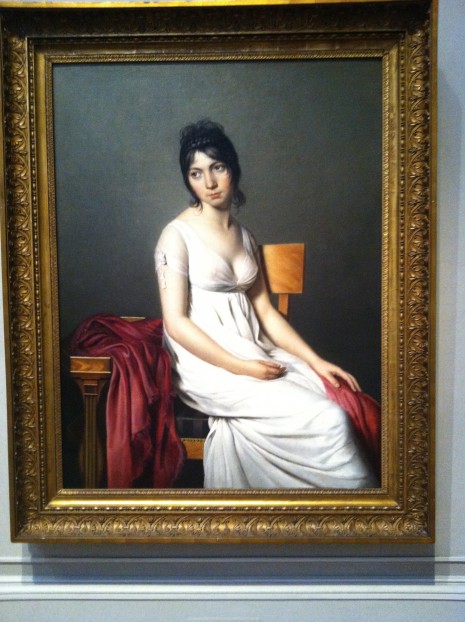Happy New Year everyone!
I’m back at my desk after lots of holiday revels, research trips, and long hours of book revisions. While in DC last weekend I went to the National Gallery in DC. It’s a pretty incredible place to go if you happen to be writing a book about fashion history. Being me, I have been doing an in-depth study of underwear, so it was fun to stumble upon this painting, attributed to the “Circle of Jacques-Louis David,” and dated 1798—that would be five years after Marie Antoinette was executed, and one year before Napoleon appointed himself “First Consul,” a.k.a dictator, and began taking over the world.
 Members of the nobility who’d survived the Revolution hastily de-corsetted and de-hooped themselves and adopted a simple, classical style based on ancient Greece. It probably won’t shock you to learn–based on the above painting–that during this period of Regency and Empire fashion, the bustline became a big focus. (“Bust improvers” enjoyed a thriving business. They were made of wax or stuffed cloth.)
Members of the nobility who’d survived the Revolution hastily de-corsetted and de-hooped themselves and adopted a simple, classical style based on ancient Greece. It probably won’t shock you to learn–based on the above painting–that during this period of Regency and Empire fashion, the bustline became a big focus. (“Bust improvers” enjoyed a thriving business. They were made of wax or stuffed cloth.)
But here’s what might shock you: it was under these thin, muslin, diaphanous dresses that for the first time ever, women began wearing underwear—by which I mean knee- or ankle-length drawers. I actually don’t think this woman is wearing any, or at least, so far as I could tell by looking at it as closely as I could without alarming the museum security guard. But according to Emily Ewing’s book Dress and Undress: A History of Women’s Underwear, it was not until this point–around the turn of the eighteenth to nineteenth century–that women stopped going commando–i.e., wearing just smocks, stays and petticoats. (If you want to know how women managed going to the bathroom in those huge panniers and hoops of the prior century, you’ll just have to read my book.)
The new style of dress for women in post-Revolutionary France emulated the fashions of the ancient Greeks, whom the French admired as the first Republic. Because people mistakenly believed that the white marble of the Greek statuary was as it had been created, most of these neoclassical style dresses were white. People didn’t realize that many of the original Greek statues had been painted in bright colors (and therefore probably the clothing had been brightly colored, too.) (Ewing 54-6)
Stories circulated that some of the more daring women wore nothing but a flimsy chemise underneath their thin muslin dresses and even misted themselves with water so that their dampened dresses clung, wet-t-shirt-style, to their bodies, but that’s unsubstantiated.
Even if it wasn’t dampened, imagine wearing this kind of dress on a cold January day, before the invention of central heating. Rates of flu and pneumonia supposedly skyrocketed. After one particularly virulent influenza epidemic carried off scores of victims, flu became known as the “muslin disease.”